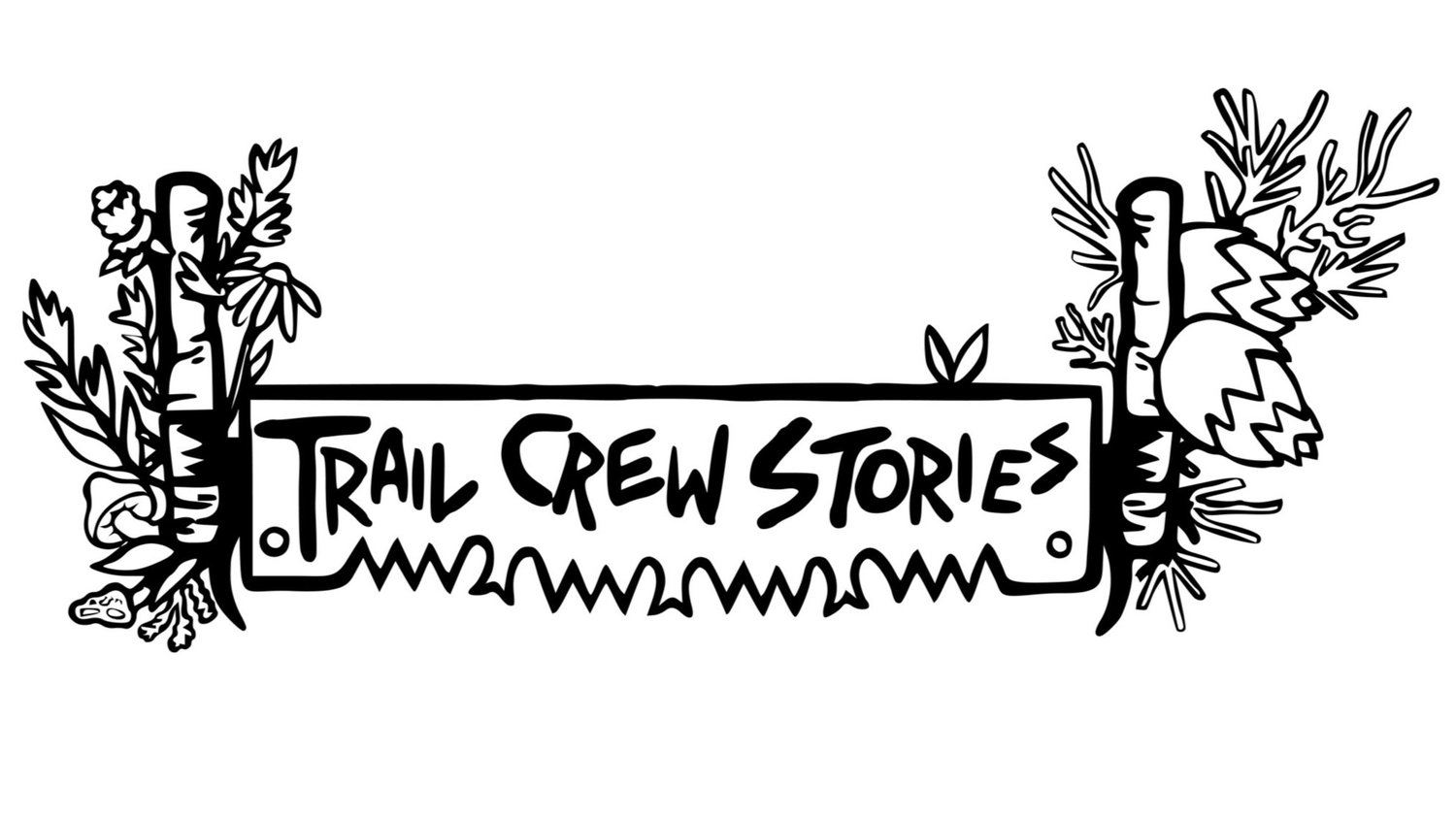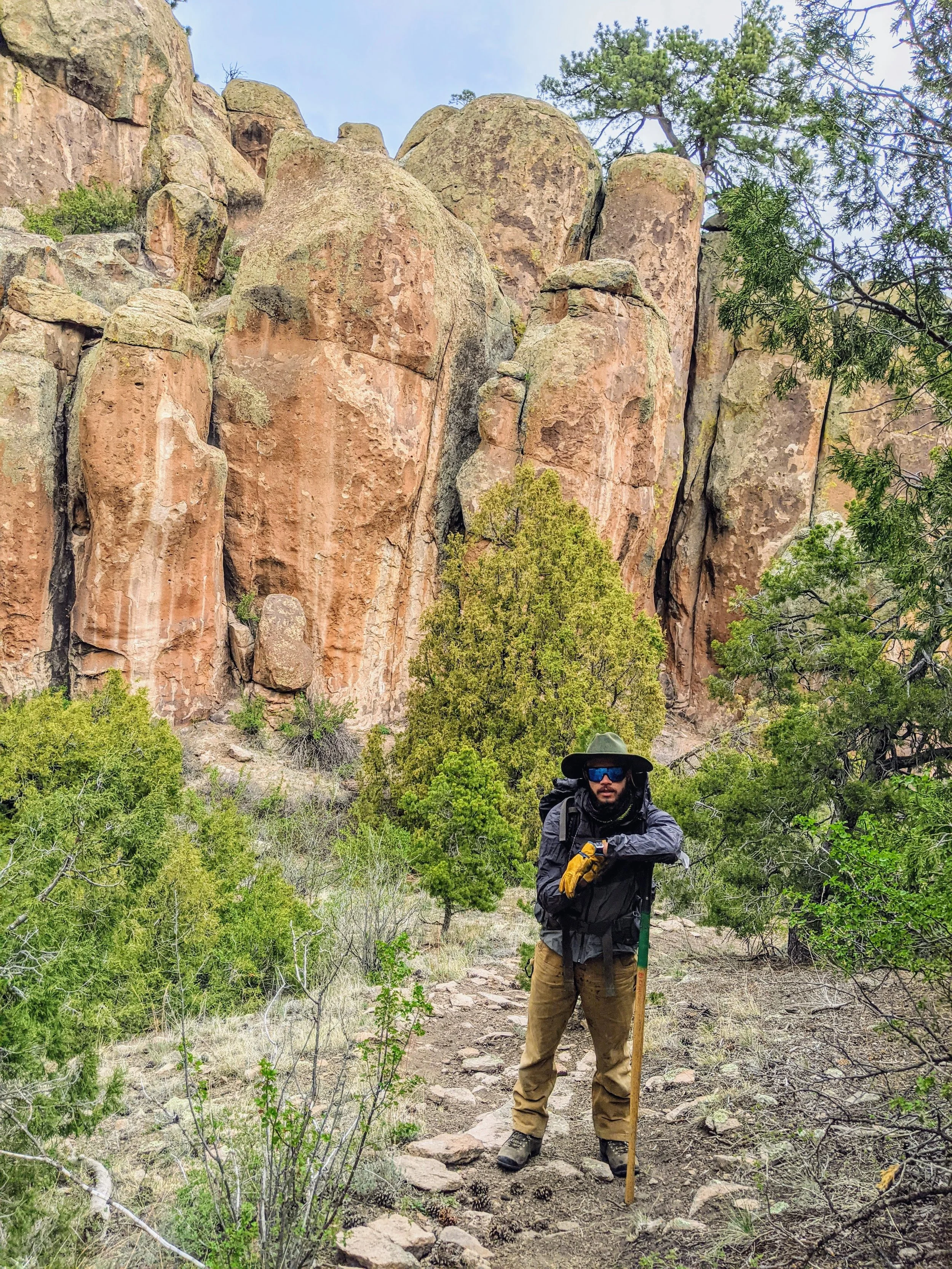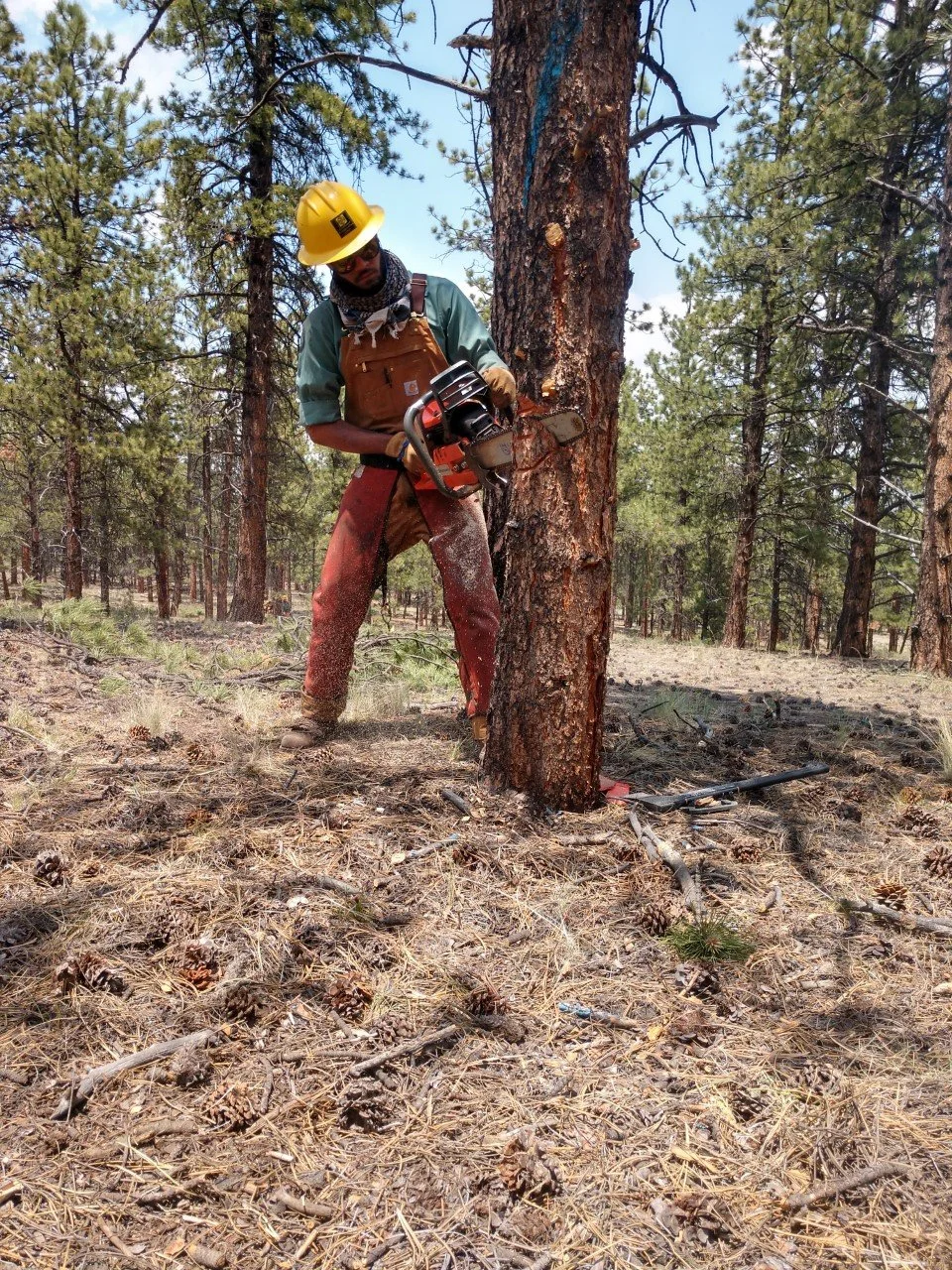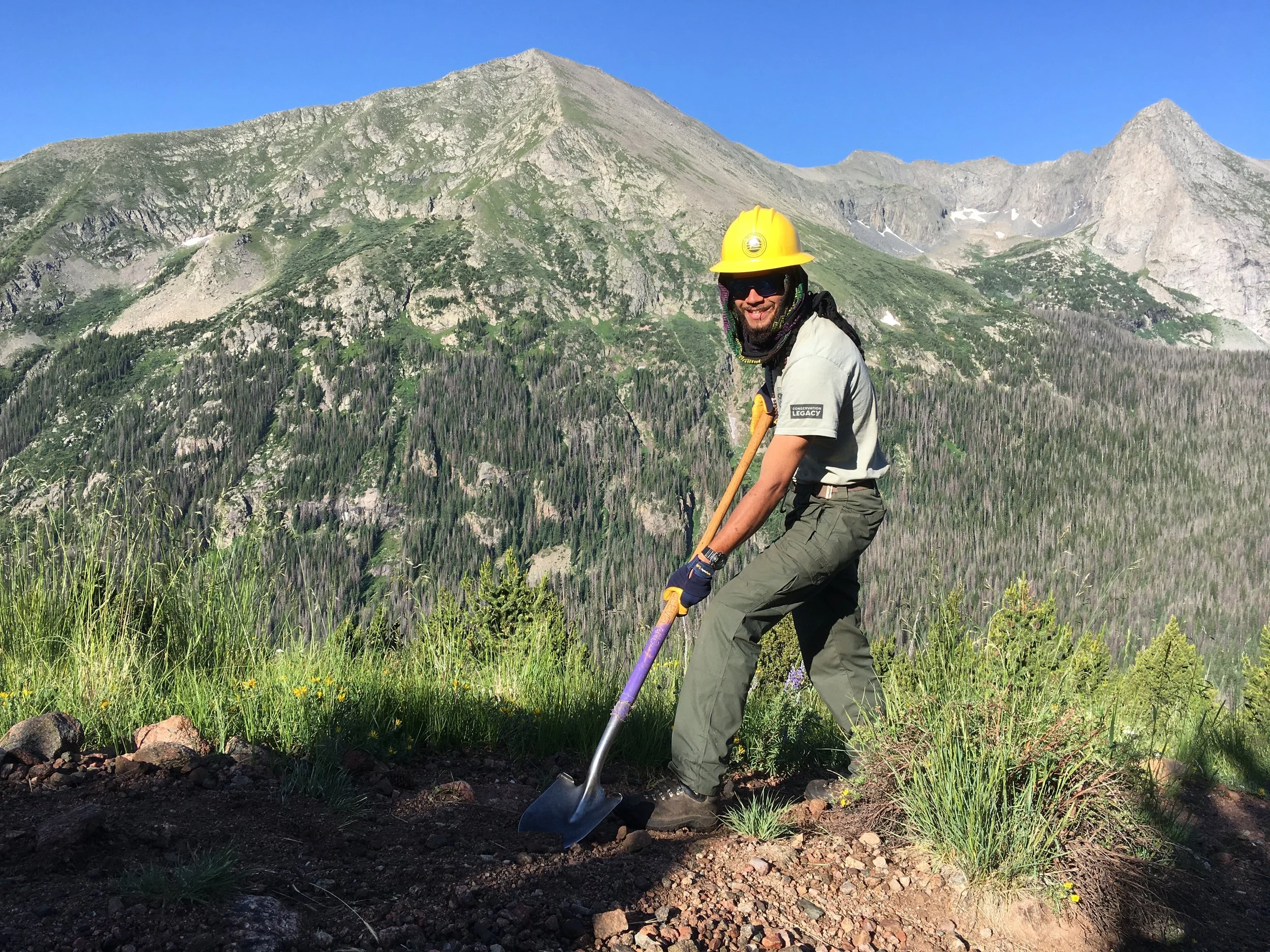Trevor Taylor: Trails to Community
Photo by Jeremy Wade Shockley
Trail workers often pride themselves on being old-fashioned: living in the backcountry without cell service; utilizing simple tools and sometimes even hundred-year-old crosscut saws; supplies—more often than not—delivered by pack mules rather than helicopters. There is certainly a romantic appeal in this simplicity and traditionalism, and this rugged romanticism is indeed what draws many of us to the lifestyle.
There are, however, historic patterns and traditions worth disrupting. In general, outdoor recreation participation in the United States does not reflect the demographics of the country itself. According to a 2022 Outdoor Industry Association report, 72 percent of outdoor recreation participants are white, despite white folks composing only 57.8 percent of the US population.
Trail work is an even more niche subset of the outdoor recreation world, and it has long been dominated by fit, young, white men who perpetuate a general stereotype of the woodsman or lumberjack as a white, bearded, flannel-clad, straight, cis-gender man in a beanie. While demographic data on trail workers is limited, I think few trail workers today would deny the lack of diversity in the field (I found one website that had some seemingly auto-generated statistics suggesting that the field is 71% white, but could not confirm their methodology).
At the same time, many trail workers are young and progressively-oriented, and acknowledge this shortcoming in the field. Momentum is growing to increase inclusivity.
Trevor Taylor is one of the young individuals driving change in the trails community. As creator and program manager of the Southwest Conservation Corps Leaders of Color Crew, Trevor leads a program with the expressed goal of empowering folks from the BIPOC community (black, indigenous, people of color) to enter the world of trails. Trevor envisions a future where both trail builders and trail users more closely reflect their local communities, and is designing innovative programming to make that happen.
I had the pleasure of working with Trevor in Colorado in 2020, and was excited to reconnect with him to share both his story and his work with Leaders of Color here on Trail Crew Stories.
Photo by Kimberly Muth
Joe Gibson: Tell me about your journey into the obscure profession of trailwork.
Trevor Taylor: Next year will mark my 10th year in conservation which is a cool milestone for me. I think even within the world of trail work I had a bit of a unique path. I started my first conservation experience on a youth crew in the city of Chicago with the student Conservation Association and Friends of the Forest Preserve.
I grew up in Chicago and I’d never gone to national parks. I never went camping. I never had any of those grandiose outdoor experiences, especially what we think about as the “great outdoors.” Instead, I had to find pockets of the outdoors and change my reference for what the “outdoors” was.
Cook County, where Chicago is seated, boasts 70,000 acres of forest reserve—which is more than people realize. My mother would take my brother and me to the forest preserves and we would run around and look for animals and explore these little pockets of natural spaces. Those were super foundational experiences. Everything from learning about seasonal changes in a visual way, to watching bucks fight during the spring, or looking for salamanders. This deep, lasting love for the outdoors came from those experiences.
That culminated in high school when I did my first trail crew. We weren't doing big, long backcountry trails in the city of Chicago, but we were doing trail work. Building our little trails through the forest reserve, maintaining those areas. Doing a lot of invasive species removal and building those foundational skills of conservation and trail work.
I did that every summer for the next five years. So I spent around six years in total with the SCA and Friends of the Forest Preserves.
I did everything from building turnpikes to check steps, to fencing, to invasive species removal, even planting and revegetation work at the Chicago Botanic Gardens. So I built up a solid background in trails. Unfortunately, with Chicago being so small and our access to the outdoors being limited, there’s not a ton of career opportunities.
Photo by Virginia Kemp
I didn't go to school for conservation or forestry or environmental studies. I studied English and Philosophy and World Religions.
I wanted to take a gap year and travel to a different part of the country, be outdoors, and make a little money. I thought, I could build trails. So this funny little skill that I developed, which is a super niche thing in the city, became my ticket to go see the “great outdoors.”
So I took that ticket and I went to Colorado. And I applied to the Southwest Conservation Corps (SCC) Los Valles office for the Fourteener Crew. I didn't know what a fourteener was. I didn't realize that it meant a mountain over 14,000 feet until I was hiking up one. I'd never seen those before. So I did a fourteener season my first year with SCC in 2019. Following that, there was no going back for me. I knew I wasn't going to grad school for philosophy or whatever to sit up in the ivory tower. I thought, this is a way I can be of service and have an impact on the world.
That idea is what really got me excited about this work and what made me think more about pursuing this as a career. It radically shifted the way my life was going as I think it does for a lot of trail workers. I did my first season with SCC in 2019, and then I met you on Kit Carson leading the crew with Virginia Kemp in 2020.
The winter after that I stayed on in a grant-funded role with SCC Los Valles to develop and create the Leaders of Color Crew, which is an affinity crew model. As far as I know, it was among the first affinity crew models—if not the first affinity crew model—for members of the BIPOC community.
Eastern Sierra Conservation Corps also deserves recognition for being one of the first conservation corps programs to prioritize recruitment from underrepresented communities. Northwest Youth Corps and Ancestral Lands Conservation Corps have also been leaders and innovators in this space. It’s hard to trace who to credit with creating the first affinity model, so please reach out if you have any insights here.
In 2022, I transitioned into full-time staff and I'm fortunate now to say this is what I do all year round.
Photo by Zach Bell
J: Tell me a little bit more about the Leaders of Color Initiative. What exactly does that look like and how do you see that initiative moving forward?
T: The Leaders of Color Crew—or the LOC Crew—is a BIPOC affinity crew model. The impetus around it is broadening the access of the world of trail building and conservation.
The outdoors in themselves are an incredibly open space, right? The trees don't care about your race, creed, sexuality, gender identity. That’s really healing for a lot of people. Unfortunately, layered within the system is the ability to access those spaces. That is because America cares deeply about how you present to the world.
For the most part, access to the outdoors is a privilege reserved to middle class and upper middle class white individuals, even in the world of trail building. Especially in the world of trail building, in some regards. That was something I struggled with when I did my first couple of seasons in Colorado.
It was a lot different from the groups that I'd worked with in Chicago. I was working with inner city kids and they were learning outdoor skills, and they fell in love with it. It was so radically different from the experiences they had in their day-to-day and at home and such a break from their normal lives.
Culturally, it's just not seen as a career for many communities of color. I think a lot of it has to do with location and not feeling safe going into certain locations. Another huge part of it is access to trainings and the certifications necessary to be competitive candidates.
So the Leaders of Color Crew tries to tackle both of those things. First and foremost we're a safe space for black, indigenous, Latinx, Asian American, and any people of color to come and learn new skills with other people of color. That’s the most important aspect of that crew model.
The LOC Crew in Mesa Verde National Park
Photo by Jeremy Wade Shockley
Because we want to launch careers in conservation, the crew focuses on a lot of technical training. The crew members start off with trail work, and they learn camping skills along with trail construction, maintenance, a little bit of trail design and the rationale behind why we build trails.
Then we move into rock work, different structures, and how to build structures well. There’s a large backcountry component, as well.
There's the opportunity for their crosscut certification, and they round out with a robust fire programming where they go through S-130/190 and S-212. So they are in a pretty good spot to get their red card and then transition into wildland firefighting. We want to open as many doors as possible.
Then we cap the season with Wilderness First Responder training, which other programs don't typically offer for their members. But we provide that for the members of the LOC Crew, because that's another huge certification that is often a barrier for many people.
S-130/190 is a wildland firefighting course that is 40 hours and typically costs about $600 per student. S-212 is the federal wildland firefighting chainsaw certification course, which is about 36 hours and typically costs about $700 per student. These courses are required for most entry-level wildland firefighting jobs.
It’s a pretty intensive program. They come out of it pretty well certed. The hope is that they can go on and then pursue those other careers. I would say we've had a pretty remarkable success rate.
Joe: Sounds like a community-centric way of developing a program.
T: There's a cultural shift happening in the outdoor and conservation world. We need to shift and start talking about things as community-focused, right?
If we think about our job and our role as trail builders, what do we do? We're providing access. And who are we providing access for? That's a huge question we need to tackle as trail builders, and in the community of trail builders. Whether it's the corps model that introduces people to it, or professional models like the National Forest Service, State Forest Service, pro trail crews.
So many are drawn to this work because it is a chance to work outside for a living, and do really cool projects, and all that is well and good. And there is the side of trails where we're protecting these environments that we really love to have a special connection to. But if we lose sight of who's using the trails or who can use the trails, then I think the work we do becomes a moot point.
Joe: Public service disproportionately serves some of the public more than others, and you have to ask, how can you make that more equitable? Do you have a vision or an ideal of what the world of conservation could and should look like? What is the ultimate goal that you'd like to see us all working towards?
T: I think that's a great question and that's something I'm personally invested in, whether it's the LOC model, or our women/non-binary/transgender affinity space or even our Opportunity Youth Affinity space.
All of that is moving towards this intersection between social justice and conservation—a conservation world, a trail building world—that reflects our country.
More than that, we can go local. We should have conservation communities and trail building communities that reflect the communities that they're serving, right? And when we get disconnected from that, we get disconnected from those communities.
Trail building, all the way up, is a form of public service. Whether it's a corpsmember summer, or the highest level of trail planning, it’s a form of public service. We're creating these things, these works of art, for other people to enjoy, to use, and to have experiences on.
That's so integral to the work that we do. We can't separate out the communities that we're serving from the communities that are building these trails. I think those things need to go hand in hand, more so than they have been.
It's been a pretty privileged world as a trail builder for a long time, and that's just the expectation of it. When we talk about sawyers, most people think of a bearded white guy. Especially in American popular culture, you think of Paul Bunyan and the lumberjacks. My hope is to challenge that and create a community in conservation that takes advantage of the safety and autonomy and the anonymity of being in the woods.
As I mentioned earlier, the outdoors don’t care how you present in the world. They don't care what your identity is. We should create trail communities that reflect that, that can hold those values. And that's a whole long fight and a pretty big fight.
But that's the goal. And I think it starts with little training opportunities like in the corps models that allows individuals to move up. We can give people the tool sets, whether that's the technical skills of becoming a technical sawyer or doing technical rock work, but also the soft skills. How to set up those boundaries, how to communicate with project partners or bosses that are probably gonna be old fashioned in the way they're thinking about things.
Photo by Jeremy Wade Shockley
J: Could you share a specific moment when you realized the LOC program was successful?
T: This past season we had a particular individual that came out and joined us right before the backcountry hitch and they didn't have any camping experience at all. They came back from the first backcountry hitch that they went on. And I said, ‘How'd it go?’
‘It was really hard.’
‘Are you gonna stick it out?’
‘We'll see how the next one goes.’
The next hitch was what that crew affectionately called the Hell Hitch. A series of things went wrong in the backcountry. When things go wrong in the backcountry, they're exponentially worse since you're miles away from everything.
But the crew got through it, and they had their time off afterwards. We were moving into the fall season and I was checking in with this member again. ‘What are you gonna do next?’
They went on to work in a program where they're leading backcountry trips for an outdoor therapy group. They went from never doing a backcountry trip, to taking those skills and now leading people to find healing and growth in the backcountry. It's leaps and bounds of growth. You don't see that everywhere else.
We had another individual with a similar path. They came out and did the first year with us and they'd never really been camping or never really done a lot of outdoor stuff. And they went on to lead NOLS exhibitions the next year after.
Moments like that are where I see it: this is working.
J: Do you have any other final thoughts, comments, hot takes for the record?
T: It always comes back down to being of service.
It's such a privilege what we get to do as trail workers. We are, in a way, curators of experience.
People that come out on a trail we built are having the experience that we have created for them. That’s a huge and wonderful thing that we get to do.
But we can't lose sight of also making sure as many people as possible can have the experience to build these trails, to be out in the woods, to do this work.
Nobody really goes into trail work because they necessarily like people or their people skills are their main thing. But trail building and trail working is such a magical community and such a wonderful way of building community that to limit who can join those communities and who has access to our communities is just a real shame.
As we build trails and as we open up access to the outdoors, we should also be building trails to our communities and opening access to who can even work on the trail, let alone be on the trail.
Photo by Emily Lynn







